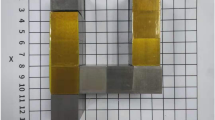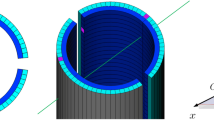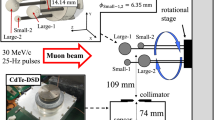Natural background particles could be exploited to detect concealed nuclear materials.
Abstract
Despite its enormous success, X-ray radiography1 has its limitations: an inability to penetrate dense objects, the need for multiple projections to resolve three-dimensional structure, and health risks from radiation. Here we show that natural background muons, which are generated by cosmic rays and are highly penetrating, can be used for radiographic imaging of medium-to-large, dense objects, without these limitations and with a reasonably short exposure time. This inexpensive and harmless technique may offer a useful alternative for detecting dense materials — for example, a block of uranium concealed inside a truck full of sheep.
Similar content being viewed by others
Main
In X-ray radiography, the intensity of an image pixel is determined by the attenuation of the incident beam caused by absorption and scattering — the maximum mean free path for photons is about 25 g cm−2 for all materials, corresponding to less than 2 cm of lead. For thicker objects, it is better to use a different type of radiography that is based on the interaction of charged particles with matter by multiple Coulomb scattering. The many small interactions add up to yield an angular deviation that roughly follows a gaussian distribution,

with the width, θ0, related to the scattering material through its radiation length, L0, as follows:

where p is the particle's momentum in MeV c−1 and βc is its velocity2. The radiation length decreases rapidly as the atomic number of a material increases, and θ0 increases accordingly: in a layer 10 cm thick, a 3-GeV muon will scatter with an angle of 2.3 milliradians in water, 11 milliradians in iron and 20 milliradians in lead. By tracking the scattering angles of individual particles, the scattering material can be mapped.
Our new technique relies on the scattering of atmospheric muons produced by primary cosmic rays. Muons are the most numerous cosmic-ray particles at sea level, moving at a rate of about 10,000 m−2 min−1 in horizontal detectors3. These particles are highly penetrating: a typical cosmic-ray muon of energy 3 GeV will penetrate more than 1,000 g cm−2 (10 m of water, for example).
To demonstrate the concept of muon radiography, we developed a small-scale experimental system with four drift chamber detectors4 spaced 27 cm apart. Each detector has an active area of 60 × 60 cm2 and records particle tracks at two positions in each of two orthogonal coordinates. The upper pair of detectors records the tracks of incident muons, and the lower pair records the scattered tracks. A tungsten cylinder was used as a test object, supported by a plastic plate and steel support beams. The tungsten is clearly visible in the reconstructed image, and the steel support beams are also evident (Fig. 1, left).
The test object is a tungsten cylinder (radius, 5.5 cm; height, 5.7 cm) on a plastic (35 × 60 × 1 cm3) plate with two steel support rails. The tungsten cylinder and the iron in the rails are clearly visible in both the experiment and simulation reconstructions. Inset, the widths of the scattering distributions for tracks passing through the tungsten target are very similar for the experimental and simulated data.
We also developed a Monte Carlo simulation code that generated cosmic-ray muons and propagated them through a test volume. The reconstructed images are indistinguishable from those obtained experimentally (Fig. 1), and the scatter angles of the simulated muons from the different materials (tungsten, lexan and steel) are consistent with the measured angles.
Simulation of larger, more complex objects demonstrates that we can reliably detect a 10 × 10 × 10 cm3 uranium object inside a large metal container full of sheep in 1 min of exposure. We conclude that cosmic-ray muons show promise as an inexpensive, harmless probe for radiography of medium-to-large objects, such as commercial trucks, passenger cars or sea containers. Our experimental results and simulations demonstrate the ability to reconstruct complex objects and to detect dense material of high atomic number hidden in a much larger volume of material of low atomic number, using only the natural flux of muons. This method is suitable for a range of practical applications in which radiography of dense objects with low radiation dose is required — for example, in surveillance for cross-border transport of nuclear materials.
References
Roentgen, W. C. Nature 53, 274 (1896).
Hagiwara, K. et al. Phys. Rev. D 66, 01001 (2002).
Grieder, P.K.F. Cosmic Rays at Earth (Elsevier Science, Amsterdam, 2001).
Atencio, L. G., Amann, J. F., Boudrie, R. L. & Morris, C. L. Nucl. Instr. Methods Phys. Res. 187, 381–386 (1981).
Author information
Authors and Affiliations
Corresponding author
Ethics declarations
Competing interests
The authors declare no competing financial interests.
Rights and permissions
About this article
Cite this article
Borozdin, K., Hogan, G., Morris, C. et al. Radiographic imaging with cosmic-ray muons. Nature 422, 277 (2003). https://doi.org/10.1038/422277a
Issue Date:
DOI: https://doi.org/10.1038/422277a
This article is cited by
-
Momentum informed muon scattering tomography for monitoring spent nuclear fuels in dry storage cask
Scientific Reports (2024)
-
Research on rapid imaging with cosmic ray muon scattering tomography
Scientific Reports (2023)
-
Fieldable muon spectrometer using multi-layer pressurized gas Cherenkov radiators and its applications
Scientific Reports (2022)
-
Material discrimination using cosmic ray muon scattering tomography with an artificial neural network
Radiation Detection Technology and Methods (2022)
-
A novel 4D resolution imaging method for low and medium atomic number objects at the centimeter scale by coincidence detection technique of cosmic-ray muon and its secondary particles
Nuclear Science and Techniques (2022)
Comments
By submitting a comment you agree to abide by our Terms and Community Guidelines. If you find something abusive or that does not comply with our terms or guidelines please flag it as inappropriate.




